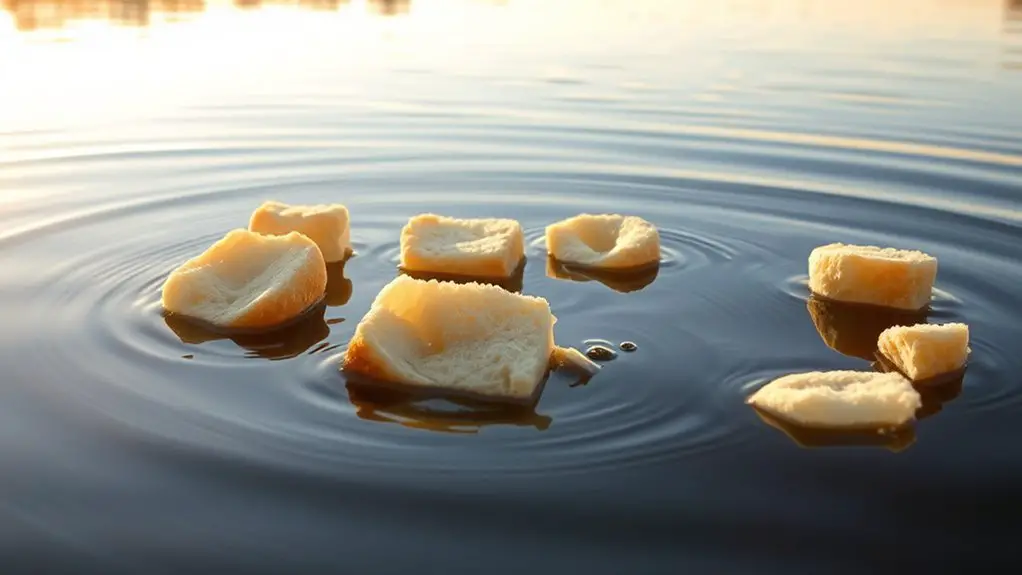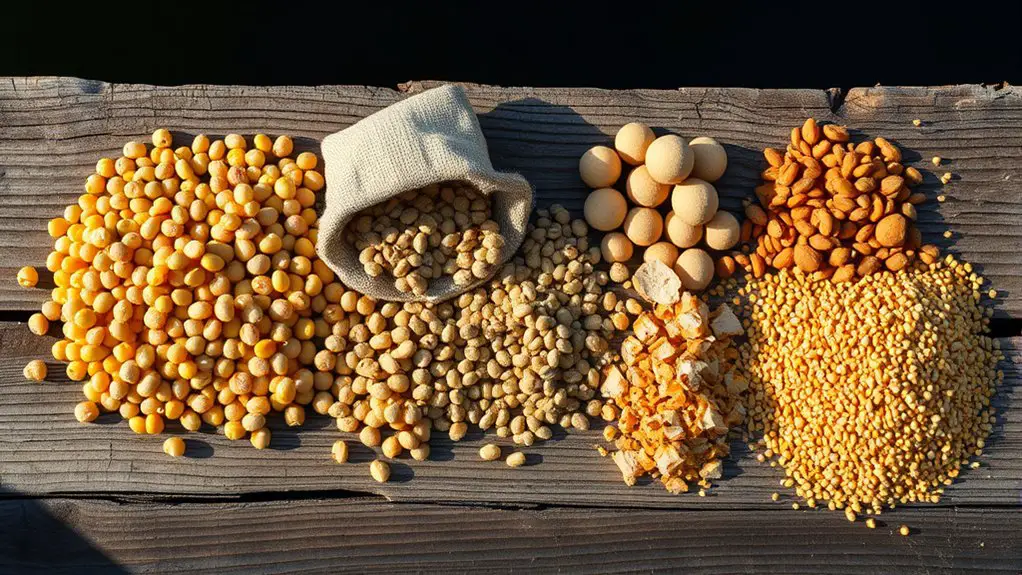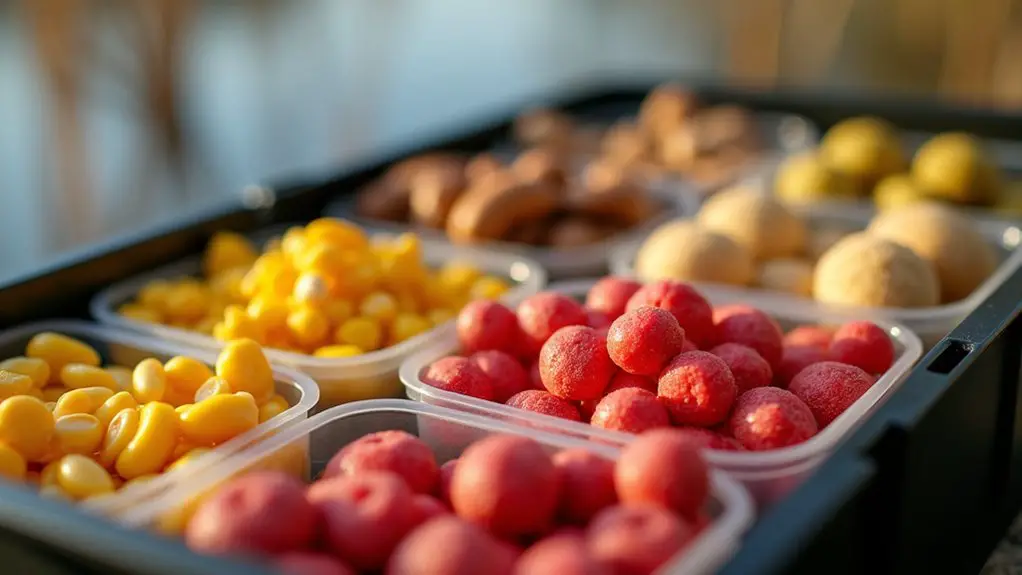Carp love sweet, colorful, and scented baits that trigger their feeding instincts. Sweetcorn stands out as a top natural option with its bright yellow color and natural sugars. Boilies offer protein-rich alternatives you can customize with flavors like strawberry or vanilla. Don’t overlook classic bread tactics for surface feeding or homemade dough balls combining cornmeal, honey, and garlic. Your seasonal approach matters too—lighter baits in spring, harder options in summer. The following sections will reveal even more carp-catching secrets.
Surf Fishing Highlights
- Sweetcorn is highly effective due to its bright yellow color, natural sugars, and versatility in both bottom and mid-water fishing.
- White bread molded on hooks attracts carp effectively, especially when using Orange Toastie Warburton for durability.
- Homemade dough balls using cornmeal-syrup, bran-cheese-honey, or garlic variations provide customizable and cost-effective options.
- Boilies in 10-24mm sizes offer protein-rich attraction with two main types: bottom baits and pop-ups.
- The Panko Jell-O and corn pack bait combines sweetcorn with strawberry flavoring for an irresistible texture and scent profile.
Understanding Why Carp Love Certain Baits
While most anglers focus simply on what baits catch fish, understanding the science behind carp preferences can dramatically improve your success rate.
Carp aren’t just randomly gobbling anything—they’re sophisticated feeders with specific triggers that influence their behavior.
Carp are discerning diners with complex feeding instincts that can be deliberately targeted for better catches.
Your success hinges on three key factors: chemical appeal (they’re suckers for sweetness!), visual attraction (bright colors like corn’s yellow), and textural qualities.
These fish learn quickly, associating certain sounds with food availability and developing cautious approaches in heavily fished waters. Recent research has shown that carp can be effectively conditioned to associate sound with bait![]() for enhanced aggregation during removal efforts.
for enhanced aggregation during removal efforts.
They’re also social eaters—where one feeds, others follow.
Both wild and domesticated carp show a strong preference for sweet corn over commercial fishing pellets because of the high sugar content![]() .
.
Scientific studies indicate that animal-derived groundbaits produce better growth rates![]() in common carp compared to plant-based alternatives.
in common carp compared to plant-based alternatives.
Understanding these behavioral patterns transforms you from a hopeful angler into a strategic carp hunter.
Sweetcorn: The Reliable Yellow Attractor
Now that you grasp the psychology behind carp feeding behaviors, let’s examine their most iconic bait—sweetcorn.
This humble yellow kernel is a carp magnet for good reason. Its bright color stands out in murky waters while natural sugars release an irresistible scent that triggers feeding responses. When initially shifting tactics from complex setups, many anglers find that plain sweetcorn![]() delivers significantly better catch rates.
delivers significantly better catch rates.
You’ll find sweetcorn works effectively both on the bottom or mid-water column, adapting to wherever carp are active. For added visibility that dramatically increases attraction, try using cured pink corn![]() that’s simple to prepare with food coloring.
that’s simple to prepare with food coloring.
For best results, try threading multiple kernels on a hair rig and chum the area generously. Carp are opportunistic feeders![]() that will readily investigate areas with concentrated food sources.
that will readily investigate areas with concentrated food sources.
While it mightn’t hold fish for marathon sessions (and smaller species love stealing it!), sweetcorn has consistently produced impressive catches, including specimens over 10 pounds.
Boilies: Customized Protein-Rich Bait Balls
When it comes to serious carp fishing, boilies stand as the undisputed champions of specialized baits in the modern angler’s arsenal.
These tough little spheres—typically ranging from 10mm to 24mm—combine cornmeal, semolina, and eggs to create a hardened outer skin that withstands nibbling nuisance fish.
You’ll find two main varieties in tackle boxes everywhere: bottom baits that rest on the lakebed and pop-ups that float enticingly above it.
The beauty of boilies? You can craft them at home with custom flavors (peach, hemp oil) and protein levels that’ll have carp queuing up for a taste.
Just mix, roll, boil, and dry! Using a sausage gun during preparation significantly speeds up the process and allows you to create uniform bait sizes![]() consistently.
consistently.
For optimal results, air drying your homemade boilies for at least two nights creates a tougher outer crust![]() while maintaining a soft, attractive middle.
while maintaining a soft, attractive middle.
Serious anglers know that boilies can be further enhanced with liquid attractors and powders to increase their appeal, especially when fishmeal-based options![]() perform exceptionally well during warmer summer months.
perform exceptionally well during warmer summer months.
Traditional Bread Tactics for Surface Feeding

Three unassuming slices of white bread might be all that stands between you and a trophy carp catch. Thick-sliced white bread outperforms its brown or seeded cousins, holding firmly on the hook while swelling enticingly when it hits the water.
You’ll want to slightly dampen your bread before molding it around a wide-gape hook (A6 works wonderfully). For extra security, try “Mega Bands”—those rubber loops that keep your bait intact during even the most ambitious casts. Many anglers find success using White Wonder bread![]() due to its superior durability when secured to hooks.
due to its superior durability when secured to hooks.
Watch for bubbles, movement, or jumping fish before casting your bread disc to visible carp. They’ll practically line up to inhale your floating feast! Many anglers prefer using orange Toastie Warburton bread for its exceptional durability![]() and ideal swelling properties when it enters the water. For the most effective presentation, try tying the hook with a blood knot
and ideal swelling properties when it enters the water. For the most effective presentation, try tying the hook with a blood knot![]() directly to 12-pound main line without added weight.
directly to 12-pound main line without added weight.
Homemade Dough Ball Recipes That Work
The five most effective homemade dough ball recipes might just revolutionize your carp fishing success this season.
The classic cornmeal-syrup combo (roll into nickel-sized balls and boil in Karo syrup) delivers consistent results when you’re targeting hungry carp.
For a protein-packed alternative, try the bran-cheese mixture with honey—it’s practically carp candy!
The oatmeal-cottonseed-molasses recipe creates a sticky, vanilla-scented dough that stays on your hook through multiple casts. When preparing this bait, ensure your mixture reaches a consistent texture![]() that breaks easily when pulled apart but isn’t overly wet. Many anglers have found that adding Code Red Mt. Dew
that breaks easily when pulled apart but isn’t overly wet. Many anglers have found that adding Code Red Mt. Dew![]() can significantly enhance the attractiveness of this bait.
can significantly enhance the attractiveness of this bait.
Want durability? Gelatin-infused dough balls won’t wash off easily.
And don’t forget the garlic variation—a stinky secret weapon that carp simply can’t resist! Traditional dough balls require just a 10-minute preparation![]() time, making them perfect for quick fishing trips.
time, making them perfect for quick fishing trips.
Creating Effective Pack Baits With Household Ingredients
Beyond mastering dough balls, pack baits represent your next level in carp fishing strategy—and you’ll be amazed what you can create from items already sitting in your pantry!
The foundation of effective pack baits lies in balancing dry and wet ingredients to achieve that perfect sticky consistency. Mix bread crumbs (about 4.4 lbs) with sweet corn, then gradually add your liquid binders. The Panko Jell-O and Corn Pack Bait recipe combines these ingredients with strawberry Jell-O![]() for enhanced attraction and flavor. Conducting a break test
for enhanced attraction and flavor. Conducting a break test![]() in a bucket of water helps ensure your mixture will break down in the optimal 1-5 minute timeframe. Adding old-fashioned oats
in a bucket of water helps ensure your mixture will break down in the optimal 1-5 minute timeframe. Adding old-fashioned oats![]() creates texture that carp find irresistible while helping maintain the proper moisture balance.
creates texture that carp find irresistible while helping maintain the proper moisture balance.
| Base Ingredients | Enhancement Options |
|---|---|
| Bread crumbs | Jell-O packets |
| Sweet corn | Vanilla extract |
| Rolled oats | Molasses/Karo syrup |
| Milk replacer | Chili powder |
Don’t refrigerate your mixture—letting it ferment slightly creates those alcohol compounds that drive carp wild!
Chumming Strategies to Establish Feeding Zones

While many beginning anglers simply cast their bait and hope for the best, successful carp fishing requires establishing strategic feeding zones through effective chumming.
You’ll attract more fish by creating competition among them rather than relying on a single bait to get noticed.
Start by distributing bait across a tennis court-sized area, combining tight clusters with scattered offerings.
Don’t overdo it! Moderate baiting triggers interest without overwhelming them. Your timing matters too—dawn periods often yield the best results.
For maximum effectiveness, select natural congregation spots near weed beds or sheltered coves. Using specialized equipment like spods or bait boats![]() can help deliver chum accurately to distant spots.
can help deliver chum accurately to distant spots.
When you see those telltale silt clouds or surface breaks, you’ve found the sweet spot!
Using a diamond pattern![]() for your chumming locations can significantly increase your fishing opportunities by covering multiple potential feeding areas.
for your chumming locations can significantly increase your fishing opportunities by covering multiple potential feeding areas.
Seasonal Bait Selection for Maximum Success
Choosing the right bait according to seasonal patterns can dramatically increase your carp fishing success rates throughout the year.
Success on the bank hinges on matching your bait selection to the seasons—it’s the difference between empty nets and trophy catches.
What works in July won’t necessarily tempt those finicky feeders in December.
- Spring – Light, fruity boilies and high-protein pellets wake up sluggish post-winter appetites.
- Summer – Hard baits like tiger nuts and sweetcorn stand up to aggressive feeding and nuisance fish.
- Fall – Liver or nut-based boilies help carp pack on pre-winter pounds.
- Winter – Downsize to maggots and bright single hookbaits when metabolism slows to a crawl.
You’ll need to adjust quantities too—from generous summer spreads to winter‘s “less is more” approach.
Frequently Asked Questions
How Do I Prevent Bait Theft From Smaller Fish Species?
To prevent bait theft, use tougher baits like plastic corn or larger dough balls that small fish can’t easily steal.
You’ll want to sharpen your hooks and secure baits with Magic Thread or mesh pouches. Fish during early mornings or evenings when those pesky little thieves are less active!
Try deeper waters away from the shallows where small fish congregate. Consider using hotdogs instead of worms (bluegill can’t resist those wiggling morsels!), and monitor your bait frequently for signs of nibbling.
Can Frozen Bait Be as Effective as Fresh Options?
Yes, frozen bait can absolutely be as effective as fresh options!
Many experienced anglers actually prefer frozen baits because they preserve freshness for months without degradation.
You’ll find that once thawed, these baits release active ingredients and natural sugars that carp find irresistible.
Modern technology has closed the gap between frozen and shelf-life baits, making your choice more about convenience than effectiveness.
Just remember to plan ahead—frozen baits need thawing time before your fishing session begins!
How Long Can Homemade Baits Be Stored Before Going Bad?
Ah, homemade bait storage—where anglers desperately fight the battle against mold that fish somehow find less appetizing than we do!
Your homemade carp baits can last anywhere from 6 months to 2 years depending on your preservation method.
Air-dried boilies can last indefinitely when kept moisture-free, while vacuum-sealed fresh baits give you an extra 2-3 months of life.
For best results, store in cool, dry places and use airtight containers.
Will Flavored Baits Work in Extremely Cold Water Conditions?
Yes, flavored baits can work in extremely cold water, but you’ll need the right approach.
Sweet, fruity or milky flavors like vanilla and cinnamon actually perform better when temperatures plummet.
However, your bait’s texture matters more than flavor—opt for smaller (10-15mm), softer options that leak attractants steadily.
Those maggots in your tackle box? Perfect winter choice! Their subtle movement attracts lethargic carp without requiring much energy expenditure from our cold, sluggish friends.
How Do Water Clarity and Temperature Affect Bait Selection?
You’ll need to adapt your bait choices as water conditions change.
In clear water, opt for natural-looking, subtle baits since carp can see them better. When it’s murky, bright colors and stronger scents will help carp locate your offering.
Temperature affects metabolism—use high-protein baits in warm water (15-22°C) when carp feed actively, but switch to sweeter, easily digestible options in colder conditions.
Conclusion
You’re now armed with an arsenal of carp-convincing cuisine! Whether you’re using nature’s candy (sweetcorn), protein powerhouses (boilies), or your kitchen creations, success comes from understanding what makes these underwater opportunists tick. Remember, seasonal adjustments and strategic chumming can turn a day of “watching your bobber” into a “bent rod bonanza.” So grab your favorite bait, find your spot, and prepare to outsmart these whiskered water warriors on your next fishing adventure!

